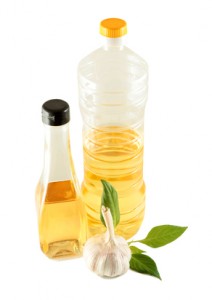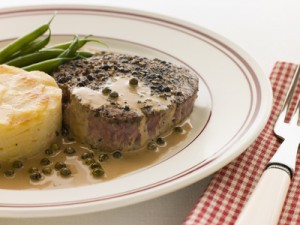
Injuries, both minor and major, are one of the hardest and most frustrating thing an athlete has to deal with.
Injuries usually seem like they occur just as you are beginning to ramp up your training for big events. And now that the weather is warming up, amateur and professional athletes are starting to pick up their training for another competitive season in their favorite sport.
Injuries can often be your body’s way of telling you are pushing it too hard, too quickly, or overtraining, and not getting enough rest and recovery in between demanding workouts.
Is there any way to prevent injuries?
Of course–you probably already know some of the things you can include in your training to prevent injury, like rest days, warming up slowly, easing into your training, and stretching.
But, did you know, your diet will also make a HUGE difference in whether you get injured and how quickly you recover?
Think of it this way: your body is a machine. Just as you work out hard to become stronger, feeding and fueling your body well will help to strengthen and maintain the muscles, tendons, ligaments, and bone in the best and strongest condition possible.
In contrast, a diet high in refined sugars, starches, and poor quality protein will result in weaker muscles, increased inflammation and a higher likelihood of injury.
So, what’s the best diet for a serious athlete or weekend warrior?
First of all, high quality protein is absolutely essential. Good protein sources are VITAL to grow and repair muscle, strengthen bones and tendons, and allow for proper function of cells.
Most training protocols tell you to eat protein right after exercise in order to help rebuild muscles; however, the best time of all may be shortly before a workout as well. It’s been found, that to limit the loss of muscle fiber associated with overuse injuries, eating protein shortly before exercising, and then immediately afterwards is best.
An active teen or adult needs to have at least 1.0 to 1.5 grams per kilogram of body weight a day.
To figure this out, one pound of body weight is roughly equivalent to about .45 kilograms. So dividing your weight in half will give you a rough estimate of your weight in kilograms.
For example, an 150 lb male would weight about 70 kilograms and will need 70-100 GRAMS of protein a day, which comes out to about 30 grams per meal, or a decent sized serving of meat, chicken, fish or eggs at every meal.
The very best, most usable protein is grass fed meat, with 5 times the muscle-building Conjugated Linoleic Acid as regular grain fed meat, healthy omega 3 fats, and important muscle-building minerals–zinc and iron.
Other great sources of protein are wild caught fatty fish, free-range poultry, and organic eggs. All of these are higher in the healthy omega 3 fats, and lower in omega 6 (inflammatory) fats, as well as being free of pesticides, antibiotics and hormones.
Many athletes rely heavily on protein bars, shakes and powders, which is a big mistake.
The protein in these processed foods is very poor. This protein usually comes from heat-processed whey or soy protein isolate. Both of these protein sources are denatured, weak versions of protein and virtually unusable by the body.
Whey protein can be an excellent protein source, but it must be cool-processed (which keeps the protein intact) and should be from grass fed dairy cows as well, for the maximum amount of CLA and healthy fats.
Healthy fats are absolutely necessary.
Fats also help to lubricate the body, muscles, tendons, ligaments, organs and skin, and increase feelings of vitality and energy.
Athletes who switch to a higher fat diet see the results with more energy, less injuries and better recovery times. Be sure to include these fats:
• Omega 3 fats–Provide plenty of fuel for energy, and anti-inflammatory properties to heal and protect the damage that hard training wreaks on the body. Omega 3 fats are found primarily in wild caught fatty fish, grass fed meat, organic eggs and grass fed butter. Walnuts, pumpkin seeds, chia seeds, and flax seeds also contain healthy doses of omega 3 fats.
• Conjugated Linoleic Acid–Helps to provide the fuel the body needs to power through a demanding practice. CLA builds muscle, burns fat, raises the metabolism, and helps prevent cancer, heart disease and high cholesterol.
• Saturated fats and cholesterol--The good saturated fats (like the kind that come from grass fed meat, organic egg yolks, and butter) actually help to strengthen and repair muscle fibers, strengthen the immune system, aid in the proper functioning of the heart, lungs and brain, and boost metabolism. So don’t shy away from these important fats. However, you do want to avoid the grain fed versions of this fat as it is high in inflammatory omega 6 fats.
• Monosaturated fats like coconut, nuts and olive oil are extremely effective at reducing inflammation and increasing energy, so be sure to include these healthy fats as well. Coconut oil is quickly and easily metabolized for energy as well as being an excellent healing agent, so be sure to include this in your diet.
Antioxidants are extremely important to athletes as well. Intense exercise creates tons of free radicals which can lead to damage and breakdown of tissue–including muscle–within the body.
Be sure to include LOTS of brightly colored fresh, organic vegetables and fruit to supply the body with the necessary antioxidants. The brighter and more colorful, the more antioxidants! Raw organic veggies and fruit contain the highest amounts of vitamins, minerals, and phytochemicals; they also contain massive amounts of enzymes because they are raw.
Enzymes are proven healers of damaged tissue.
To prevent and heal injuries try to eat at least 50% or more of these raw.
Vitamin C is one of the most powerful antioxidants and is also very important for the repair of the collagen, connective tissue, and cartilage; it is helpful add extra to your diet when injured.
Aim for five or more sources of foods that are high in vitamin C such as red peppers, papaya, cantaloupe, kale, oranges and broccoli.
And don’t forget about Vitamin A for its rebuilding properties.
Higher amounts of vitamin A also aid in repairing micro-tears that occur after a hard workout, so it is a valuable addition for any runner, cyclist or weight lifter. Best food sources of vitamin A are: grass-fed dairy products such as raw cheese, grass-fed butter, and grass-fed (commercially raised beef liver contains lots of toxins) liver; bright orange or red vegetables such as carrots, sweet potatoes, mangoes, papaya, winter squash, red peppers, apricots and spinach.
Digestive enzymes also aid in the recovery process.
Look for ones that contain plenty of bromelain and protease, and take with meals. Bromelain is an enzyme found in pineapple, and is effective as an anti-inflammatory. Protease is an enzyme that digests proteins and will travel to the injured sites to dissolve the byproducts of the injury. Other enzymes have similar healing effects.
One of the most important building and repairing nutrients for injuries is zinc.
Zinc works alongside protein and other nutrients in the body synergistically. Zinc is also an immune enhancer which is powerful in the whole healing process. To ensure you are getting enough, include grass-fed beef, liver, oysters and other shellfish, seeds, nuts, chicken and egg yolks in your diet.
So now you know what foods to be sure to include in your diet, but there are definitely some foods that must be avoided as well.
These foods not only fatigue the body, run down the immune system, and interfere with the processing of important nutrients, but they also contribute to inflammation in the body.
A tough and demanding training plan adds enough inflammation, so why add to that burden?
Inflammatory foods include the obvious junk foods–cookies, candy, excess alcohol, processed foods, and artificial foods with chemicals and preservatives.
Sneaky food additives (even in so-called health foods) such as transfats, omega 6 oils such as corn oil, sunflower oil, safflower oil, grains of all kinds including wheat, rice, oats, corn, and soy ( a legume) and sugars are also highly inflammatory as well.
Many athletes are switching to a gluten free training diet, even if they do not have gluten issues.
Gluten is a protein in wheat, rye and barley. It has been found that gluten is an inflammatory agent in many people (even those who seemingly do not have issues with gluten sensitivity) to some degree.
Athletes who have adopted a gluten free training diet report that they feel more energetic, less sluggish, lose a little weight, sleep better, have better digestion and generally feel better overall.
Sugar in all forms is highly inflammatory and actually stimulates an inflammatory response, so avoid it at all costs.
Pasteurized, processed dairy foods, (as opposed to raw dairy) also tend to add to inflammation.
Dairy contains a lot of histamines, which will add to the inflammation already present in the body.
And last of all, be sure to be getting enough water.
Water helps to carry away toxins and keep your metabolism and healing processes working efficiently. There is no excuse not to stay well hydrated as the benefits are really endless.
You will feel better, have better energy and heal quicker!
Eat well, work hard and you will most definitely reap the benefits of a stronger, faster body!
Till next time, stay healthy, lean and active!

 Catherine (Cat) Ebeling RN BSN, is a back to basics diet and nutrition specialist. In addition to her advanced degree in nursing from a major medical school, she has spent the last 30 years intensely studying diet, health and nutrition. She also has a book titled “The Fat Burning Kitchen, Your 24 Hour Diet Transformation” that has sold over 60,000 copies worldwide, and has helped thousands of people transform their lives, lose weight and improve their health.
Catherine (Cat) Ebeling RN BSN, is a back to basics diet and nutrition specialist. In addition to her advanced degree in nursing from a major medical school, she has spent the last 30 years intensely studying diet, health and nutrition. She also has a book titled “The Fat Burning Kitchen, Your 24 Hour Diet Transformation” that has sold over 60,000 copies worldwide, and has helped thousands of people transform their lives, lose weight and improve their health.
Her mission is to help others prevent disease and live their best life ever.
Nutrition made Easy. Simple.Smart.Nutrition.
References:
Michelle Schoffro Cook, DNM, DAc, CNC, CITP, The 12 Step Program to Healing Sport Injuries http://hubpages.com/profile/Shannon+Clark Horwitz,
Dr. Steven, Omega 3 Fatty Acids and Inflammation, Prevent Sports Injuries, Jan 21, 2011. http://preventsportsinjuries.blogspot.com
 Catherine (Cat) Ebeling RN BSN, is a back to basics diet and nutrition specialist. In addition to her advanced degree in nursing from a major medical school, she has spent the last 30 years intensely studying diet, health and nutrition. She also has a book titled “The Fat Burning Kitchen, Your 24 Hour Diet Transformation” that has sold over 60,000 copies worldwide, and has helped thousands of people transform their lives, lose weight and improve their health.
Catherine (Cat) Ebeling RN BSN, is a back to basics diet and nutrition specialist. In addition to her advanced degree in nursing from a major medical school, she has spent the last 30 years intensely studying diet, health and nutrition. She also has a book titled “The Fat Burning Kitchen, Your 24 Hour Diet Transformation” that has sold over 60,000 copies worldwide, and has helped thousands of people transform their lives, lose weight and improve their health. 









